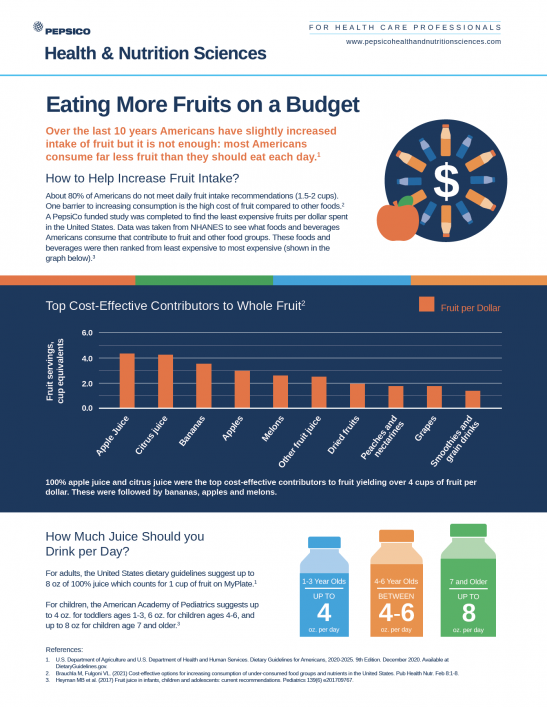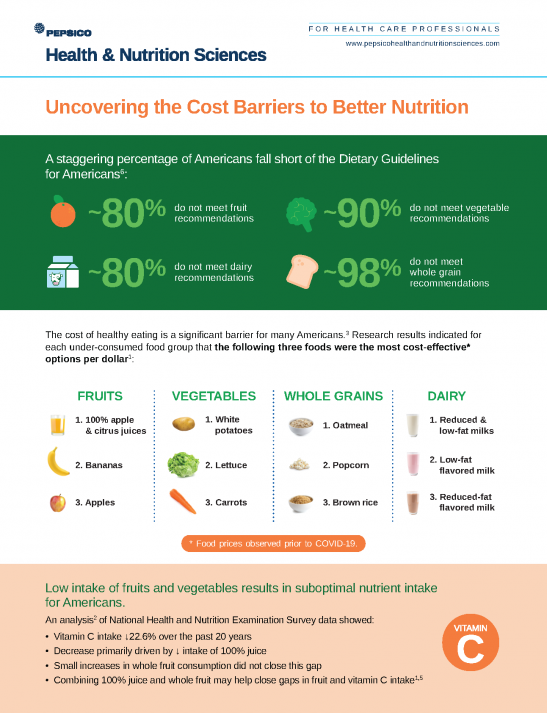Brauchla, M., & Fulgoni, V. L. (2021). Cost-effective options for increasing consumption of under-consumed food groups and nutrients in the United States. Public Health Nutrition, 1-18. doi:10.1017/S1368980021000537
Abstract:
Objective: To identify the most cost-effective options/contributors of under-consumed food groups and nutrients in the USA. Design: Twenty-four-hour dietary recall data were used for the dietary sources of under-consumed food groups and nutrients. Costs were estimated using USDA National Food Price Database 2001–2004 after adjustments for inflation using Consumer Price Index. Setting: National Health and Nutrition Examination Survey, 2013–2016. Participants: A total of 10 112 adults aged 19+ years. Results: Top five cost-effective options for food groups were apple and citrus juice, bananas, apples, and melons for fruit; baked/boiled white potatoes, mixtures of mashed potatoes, lettuce, carrots and string beans for vegetables; oatmeal, popcorn, rice, yeast breads and pasta/noodles/cooked grains for whole grain; and reduced-fat, low-fat milk, flavoured milk and cheese for dairy. Top five cost-effective sources of under-consumed nutrients were rice, tortillas, pasta/noodles/cooked grains, rolls and buns, and peanut butter–jelly sandwiches for Mg; grits/cooked cereals, low- and high-sugar ready-to-eat (RTE) cereal, rolls and buns, and rice for Fe; low- and high-sugar RTE cereals, rice, protein and nutritional powders, and rolls and buns for Zn; carrots, margarine, other red and orange vegetables, liver and organ meats, butter and animal fats for vitamin A; and citrus juice, other fruit juice, vegetable juice, mustard and other condiments, and apple juice for vitamin C. Conclusions: Apple/citrus juice, white potatoes/carrots, oatmeal, RTE cereals and milk were the most cost-effective food sources of multiple under-consumed food groups and nutrients and can help promote healthy eating habits at minimal cost.
Talavera, J. O., García-Vilchis, M. J., Labrada-Alba, T. S., Olvera-Flores, F., . . . Salgado-Enríquez, B. (2020). Moderate acute malnutrition prevention with a ready-to-use supplementary food in pre-school children from rural communities. Gaceta medica de Mexico, 156(6), 499–508. doi:10.24875/GMM.M21000454
Abstract:
Introduction: Child malnutrition in Mexico reaches a prevalence as high as 27.5 % in rural areas. Objective: To assess the effectiveness of a ready-to-use supplementary food (RUSF) to correct mild acute malnutrition and prevent moderate acute malnutrition in preschool children from rural communities. Method: Randomized clinical trial, with assignment to two groups: group with RUSF (RUSF-g) or group without it (non-RUSF-g); children aged from two to five years, with weight-for-height Z-scores (WHZ) between -2 and -1 and low socioeconomic status were included. All received education on nutrition, health and hygiene twice monthly; the RUSF-g children had to consume one portion of the supplement every day. WHZ was assessed at baseline and at four, six, and 12 months. The comparison between groups was carried out with Cox proportional hazards model. Results: With regard to mild acute malnutrition correction in the RUSF-g, 68.7 versus 52.1 % in the control group was observed in the intent-to-treat analysis, with a hazard ratio (HR) = 1.25; in the per-protocol analysis of first semester, a HR = 1.48 was observed, and in the second semester, HR = 1.56. One patient progressed to moderate acute malnutrition. Conclusions: The RUSF-g showed




